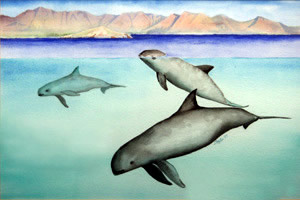
The vaquita is one of the most endangered species of marine mammals
Research published in the academic journal Mammal Review has uncovered the missing link in the depleting population of the vaquita. With a body less than 1.5 m long, the vaquita is the smallest living cetacean (the order Cetacea consists of whales, dolphins and porpoises). It also has one of the smallest ranges (c. 2235 km2) and one of the smallest populations (< 600 individuals based on a 1997 survey). This little porpoise is one of the two most critically endangered small cetaceans in the world, suggesting that its chances of survival are small, just like its population size and area of distribution. So, what actions have been and are being taken to prevent the vaquita's extinction and promote its recovery" In a recent paper published in Mammal Review, the authors from Mexico and Canada reviewed the scientific issues, described previous and ongoing conservation efforts, and identified remaining obstacles, established priorities, and provided recommendations.
The vaquita is endemic to the north-western corner of the Gulf of California (north of 30º45'N and mainly west of 114º20'W), an area rich and diverse in marine mammals. It is somewhat surprising that the porpoises are limited to such a small area when there are no obvious physical barriers to prevent them from moving into the rest of the Gulf. However, there is no evidence that the vaquita's overall range has changed in historic times. Acoustic surveys suggest that vaquitas are not only limited to the north-western Gulf all the year-round, but also that their current distribution is more restricted than previously thought – confined to a small area off the eastern coast of the Baja California Peninsula.
What is driving the vaquita towards extinction? It is not, as is so often the case, degradation of its habitat. A risk factor analysis discounted pollution or the drastic reduction of freshwater flow from the Colorado River as primary culprits. It is also not a genetic problem. Genetic analyses and population simulations suggested that the vaquita has always been rare and that its extreme loss of genomic variability occurred over evolutionary time rather than recently owing to human-caused mortality. Instead of those factors, the "smoking gun" in this instance is accidental mortality in fishing gear, something popularly known as "bycatch".
Large-, medium- and small-mesh gillnets set for fish and shrimp entangle and kill vaquitas far too frequently. The best available quantitative estimate of bycatch refers to only one of the three main fishing ports: 39 vaquitas/yr (95% CI: 14, 93). Current population size could well be around 400 animals. If the vaquita goes extinct, its story will be the chronicle of an announced extinction. For decades scientists from Mexico and abroad, in various international and national fora, have warned the Mexican Government that the vaquita was at risk of being extirpated as a result of the bycatch. The Government has ignored such warnings and chosen to blame the vaquita's precarious condition on the lack of water in the Colorado River – a result of damming and diversion in the United States. No data have been offered in support of this idea and, in fact, the Upper Gulf remains a very rich and productive ecosystem.
Is the vaquita destined to become the first marine cetacean to go extinct in modern times because of anthropogenic factors" How can this sad prospect be prevented" The small number of porpoises in the current population cannot be expected to withstand continuing incidental mortality. This needs to be eliminated. However, progress towards even reducing, much less stopping, vaquita bycatch has been painfully slow despite efforts to phase-out fishing with gillnets in the core area of vaquita distribution and to devise schemes involving compensation, incentives and alternative livelihoods for fishermen.
For the first time since 1958, when the vaquita was scientifically described and named as a species, the Mexican Government has finally taken specific actions to try to prevent its extinction. On 29 December 2005 the Ministry of Environment declared a Vaquita Refuge that contains within its borders approximately 80% of all verified vaquita sighting positions. In the same decree, the State Governments of Sonora and Baja California were offered $(US)1 million to compensate affected fishermen. Another big step will be to convince the relevant State Governments of the Upper Gulf to support actions proposed by an international vaquita recovery team. These Governments have argued that no action should be taken until a second survey for a new abundance estimate shows definitively that the population is declining.
But the question of how often new estimates or indices must be obtained to monitor trends is a tricky one. Ship surveys are expensive and they cannot be expected to detect population declines or increases on an acceptable timescale for such a critically endangered species. According to one analysis, a single survey in 2006 or 2007 would have a probability of only 11% of detecting a 3%/year decline and a 16% probability of detecting a 10%/year decline. Achieving an acceptable probability (e.g. 95%) of detecting a 3% decline would require annual surveys over a period of 39 years at a cost of approximately $29 million. Moreover, by that time (c. 45 years from now) only some 180 or so vaquitas would be left. Clearly, it is wiser to invest available funds in conservation actions, particularly in ones that offer viable socioeconomic alternatives to fishermen.
Mexico has a very good record in helping endangered marine mammals to recover. There are no better examples anywhere in the world than eastern Pacific gray whales and northern elephant seals, both of which came back from low numbers and now represent true conservation success stories. Similar efforts are needed urgently for the vaquita, a small animal living in a small area with a small, and ever-smaller, population.
